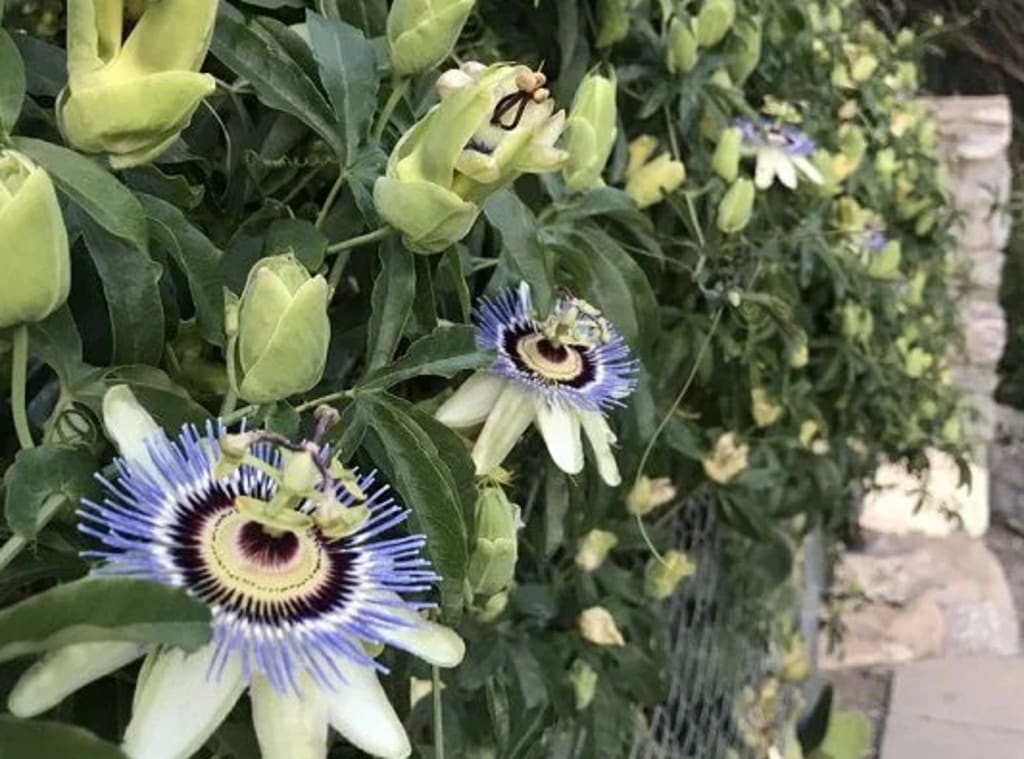
Passion fruit, scientifically known as Passiflora edulis, is a tropical vine famous for its unique and exotic fruit. However, before this delectable fruit can develop, it goes through a fascinating process that begins with its distinctively beautiful flower.
The passion fruit flower is a complex and visually striking blossom. It typically features five sepals and five petals, with a diameter of 5–10 centimeters. What sets it apart is its intricate structure, which has earned it the nickname “clock flower.” The petals and sepals vary in color, often a mix of white, purple, or pink, and they radiate outwards in a radial pattern.
The most captivating aspect of the passion fruit flower is its reproductive system. At its center, a unique arrangement of filaments and structures forms a crown-like structure called the corona. This corona is where the magic happens. It serves a dual purpose: attracting pollinators and facilitating reproduction.
To attract pollinators like bees and hummingbirds, the corona produces a sweet nectar. As these creatures visit the flower for nectar, they inadvertently brush against the flower’s pollen-covered anthers, transferring pollen from one flower to another in a process called cross-pollination. This interaction is crucial for fruit development.
Once pollination occurs, the flower transforms into a fruit, commonly known as a passion fruit. This fruit has a tough outer rind, enclosing a juicy interior filled with aromatic, seed-filled pulp. It’s this pulp that’s prized for its sweet-tart flavor and used in a variety of culinary applications, from juices and desserts to sauces and cocktails.
In summary, the passion fruit flower is a stunning creation of nature, not only for its aesthetic appeal but also for its role in the lifecycle of the passion fruit vine. Its intricate design, nectar production, and unique reproductive system are all essential components in the creation of the delicious and exotic passion fruit that many people around the world enjoy.

2.Naupaka
Naupaka, also known as Scaevola taccada or beach naupaka, is a distinctive coastal shrub or small tree found in tropical and subtropical regions, particularly in the Pacific Islands and parts of Asia. It is renowned for its unique appearance and cultural significance.
The most remarkable feature of the naupaka plant is its striking half-flower. Each individual flower appears to be missing one half, giving it the appearance of a half-circle or crescent. This distinctive shape has given rise to various Hawaiian legends and tales explaining the naupaka’s unusual form. One such legend tells of two lovers, separated by fate, with one half of the naupaka flower found by the sea and the other in the mountains, symbolizing their enduring but incomplete love story.
Naupaka is well adapted to coastal environments, with its lush, leathery leaves and small white or pale lavender flowers. It is a hardy plant that thrives in sandy soils and is often used for beachside landscaping due to its ability to tolerate salt spray and harsh coastal conditions.
In addition to its cultural significance and distinctive appearance, naupaka has been used in traditional medicine for various purposes, including treating skin conditions and digestive issues. Overall, the naupaka is a captivating and culturally rich plant that continues to hold a special place in the hearts of those who encounter it along tropical coastlines.

3.Protea
Protea is a diverse and captivating genus of flowering plants native to the Southern Hemisphere, particularly South Africa and Australia. With over 1,500 recognized species, proteas are known for their stunning and distinctive floral structures, making them a favorite in gardens, floral arrangements, and even as national symbols.
The most iconic feature of protea flowers is their unique appearance. They often have large, globe-shaped flower heads with a central, dome-like structure surrounded by colorful, petal-like bracts. These bracts can come in a wide range of colors, including shades of pink, red, orange, yellow, and cream. The central dome is adorned with intricate patterns of tiny, tubular flowers that attract pollinators like birds and insects.
Proteas are celebrated for their resilience, with many species adapted to thrive in harsh, fire-prone environments. They have thick, leathery leaves and well-developed root systems that allow them to survive in nutrient-poor soils. Additionally, some protea species require exposure to wildfire for their seeds to germinate, making them ecologically dependent on periodic fires.
Beyond their aesthetic appeal, proteas hold cultural significance in their native regions. For example, the King Protea (Protea cynaroides) is the national flower of South Africa, symbolizing beauty, change, and hope in the country. These remarkable flowers have also gained international popularity for their use in floral arrangements, making proteas a cherished and distinctive part of the world’s botanical landscape.





Comments
There are no comments for this story
Be the first to respond and start the conversation.